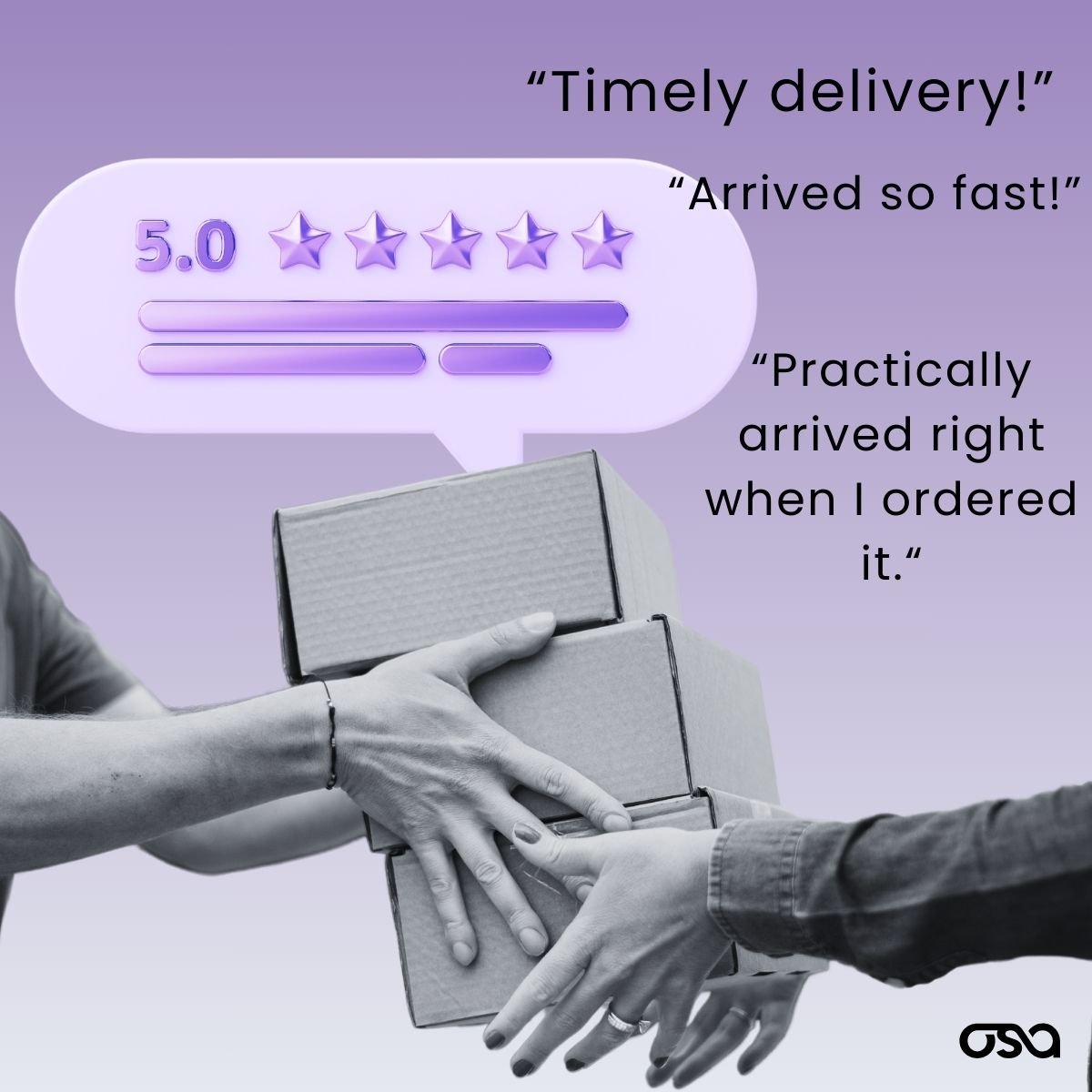
Discover the essential supply chain metrics that can drive success for brands and Third-Party Logistics (3PL) providers. Track these KPIs with the Osa Commerce Collaborative Visibility Platform.
Tips for Measuring Key Metrics
While it's important to define your important supply chain metrics it's also important to know how to measure them effectively.
- Define KPIs that will clearly and effectively measure success for your company.
- Collect data and establish reporting for these KPIs.
- Analyze data frequently.
- See what the rest of the industry is doing and benchmark next to their best practices and results.
- Don't shy away from new technology, it is the future after all!
- Go from reactive to proactive with predictive analytics.
If you're wondering why it is necessary to measure your supply chain performance, it all boils down to the ability to improve and positively affect the bottom line. For example, it can allow you to fix many elements of your supply chain like improve customer satisfaction, increase efficiency, cut costs, decrease risks, breakdown data siloes, and overall increase connectivity.
1. Important Logistics Measurement - On-Time Delivery Rate
On-time delivery rate is a crucial supply chain metric that measures the percentage of orders delivered on time. It is an indicator of the efficiency and reliability of the logistics process. By tracking this metric, brands and logistics providers (3PLs) can ensure that they meet customer expectations and maintain a high level of customer satisfaction.
Maintaining a high on-time delivery rate not only boosts customer retention and referrals but also signifies efficient supply chain management. It showcases well-organized processes from order processing to transportation, reducing operating costs by cutting inventory holding expenses and the necessity for expedited shipping while mitigating stockouts and potential penalties.
Tracking on-time delivery rates can be done by monitoring the delivery dates and comparing them to the promised delivery dates. Any delays or missed deliveries should be recorded and analyzed to identify the root causes and implement corrective actions.
Achieving a high on-time delivery rate requires effective coordination between different stakeholders in the supply chain, including suppliers, manufacturers, distributors, and transportation providers. It also involves optimizing transportation routes, managing inventory levels, and improving communication and visibility throughout the supply chain. This can all be made possible by the addition of artificial intelligence (AI) into the supply chain.

2. Increase Inventory Turnover Ratio
Inventory turnover ratio is a measure of how quickly inventory is sold and replaced within a given period. It helps brands and logistics providers assess the efficiency of their inventory management and identify opportunities to optimize it. Now we've talked about this before but it is absolutely crucial for a smooth operating supply chain.
A high inventory turnover ratio indicates that inventory is being sold quickly, effective demand forecasting, reducing the risk of obsolescence, and freeing up working capital. Improved product availability boosts customer satisfaction and profitability.
On the other hand, a low inventory turnover ratio suggests that inventory is not moving as fast as desired, potentially leading to higher carrying costs and increased risk of inventory becoming obsolete.
To increase the inventory turnover ratio, brands and logistics providers can implement strategies such as improving demand forecasting accuracy, implementing just-in-time inventory management, optimizing warehouse layout and organization, and leveraging data analytics to identify slow-moving or obsolete inventory.
Tracking the inventory turnover ratio can be done by dividing the cost of goods sold by the average inventory value during a specific period. Regularly monitoring this metric allows brands and logistics providers to identify trends, make data-driven decisions, and continuously improve their inventory management practices.
You may be wondering how to calculate this ever-important metric, well here's the formula:
Inventory turnover = cost of goods (COG) sold / average value of inventory
3. Track Supply Chain KPIs With Order Accuracy Rate
Order accuracy rate measures the percentage of orders that are fulfilled correctly and without errors. This is reflective of the efficacy of the supply chain's inventory management and order management. It is a critical metric for ensuring customer satisfaction and minimizing the costs associated with order errors, such as returns, replacements, and customer complaints.
To track the order accuracy rate, brands and logistics providers can compare the number of orders received to the number of orders fulfilled accurately. Any discrepancies should be investigated to identify the root causes and implement process improvements.
Achieving a high order accuracy rate requires effective coordination and communication between different stakeholders in the supply chain, including sales teams, warehouse staff, and transportation providers. It also involves implementing quality control measures, such as barcode scanning, order verification processes, and regular training for employees.
By tracking and improving the order accuracy rate, brands and logistics providers can enhance customer satisfaction, build trust and loyalty, and reduce all costs associated with order errors.

4. Measure Supply Chain Warehousing Costs
Warehousing costs are a significant component of the overall supply chain expenses. Tracking and managing these costs is essential for optimizing the supply chain and improving profitability.
There are various costs associated with warehousing, including rent or mortgage, utilities, labor, equipment, insurance, and maintenance. By accurately measuring and analyzing these costs, brands and logistics providers can identify opportunities to reduce expenses and improve operational efficiency.
To measure warehousing costs, brands and logistics providers can calculate the total cost per square foot or per unit of inventory stored. They can also track specific cost categories, such as labor costs or utilities costs, and compare them to industry benchmarks or historical data.
Reducing warehousing costs can be achieved through strategies such as implementing warehouse automation, optimizing inventory levels, improving layout and space utilization, and negotiating favorable contracts with suppliers and service providers. Regularly reviewing and analyzing warehousing costs allows brands and logistics providers to identify cost-saving opportunities and make informed decisions to drive profitability.
5. Gross Margin Return on Investment - The Key To Unlocking Supply Chain Success
Gross Margin Return on Investment (GMROI) is a financial metric that measures the profitability of inventory investments. It helps brands and logistics providers assess the effectiveness of their inventory management and make informed decisions to maximize profitability.
GMROI is calculated by dividing the gross margin (sales minus the cost of goods sold) by the average inventory investment. A higher GMROI indicates that the inventory is generating a higher return on investment.
By tracking and improving GMROI, brands and logistics providers can optimize their inventory assortment, pricing strategies, and promotional activities. They can identify which products or categories are contributing the most to profitability and allocate resources accordingly.

To track GMROI, brands and logistics providers need to have accurate and up-to-date financial and inventory data. They can use inventory management software to calculate this metric.
This is obtained by dividing gross profit by average inventory investment, it offers valuable insights into inventory performance. Tracking this key performance indicator (KPI) monthly helps identify underperforming items and highlights worthwhile investment opportunities, providing invaluable business intelligence.
By focusing on GMROI, brands and logistics providers can achieve supply chain success by maximizing profitability, reducing inventory carrying costs, and aligning inventory investments with customer demand.
How Does Unified Commerce Help Track Key Supply Chain Metrics?
Unified commerce refers to the integration of all sales channels and touchpoints into a single, seamless platform. It enables brands and logistics providers to track key supply chain metrics more effectively and make data-driven decisions. The good news, Osa Commerce has its own AI-powered version labeled the Collaborative Visibility Platform.
With unified commerce, brands and logistics providers can have real-time visibility into inventory levels, order status, and customer data across all channels. This visibility allows them to track and analyze supply chain metrics such as on-time delivery rate, inventory turnover ratio, order accuracy rate, warehousing costs, and GMROI.
By having access to accurate and up-to-date data, brands and logistics providers can identify trends, spot potential issues, and implement proactive measures to improve supply chain performance. Collaborative Visibility also enables better collaboration and communication among different stakeholders in the supply chain, leading to enhanced efficiency and customer satisfaction.

The Osa Commerce Collaborative Visibility Platform is a prime example of an AI-driven unified commerce solution that can help brands and logistics providers track and optimize key supply chain metrics. It provides real-time, end-to-end visibility into the supply chain, enabling proactive decision-making and driving success.


